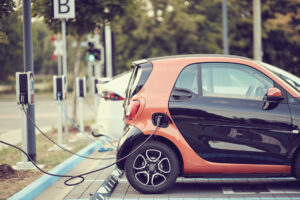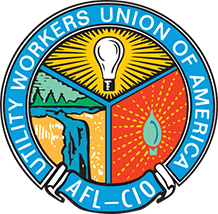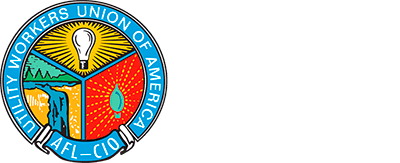By Jim Harrison, UWUA Director of Renewable Energies
As U.S. automakers go all-in on electric vehicle manufacturing, the industry is at a turning point. Making electric vehicles (EVs) affordable and accessible for all classes of consumers is predicated on those consumers being able to charge their vehicles quickly and economically. Auto manufacturers, utility companies, state regulators and federal agencies know this, and many states have been working with electric utilities to develop charging infrastructure and incentives for adoption. Furthermore, as a means of reducing utility fleet emissions and providing more visibility, we anticipate some companies will follow National Grid’s example and replace existing vehicle fleets with electric vehicles.

The Edison Electric Institute (EEI), the association of investor-owned U.S. utilities, estimates we will need more than 100,000 fast-charging EV ports to support the projected 22 million EVs that will be on U.S. roads by 2030. The Biden administration recently announced an even more ambitious plan of creating over 500,000 EV charging stations.
In January, EEI launched its National Electric Highway Coalition, which brings EEI’s members together with an electric cooperative, the Tennessee Valley Authority, the Electric Highway Coalition and the Midwest Electric Vehicle Charging Infrastructure Collaboration. The coalition’s goal is to construct a fast-charging EV network that will cover all major U.S. travel corridors by the end of 2023. This huge investment builds upon $3 billion in state investments in EV charging infrastructure and electric transportation.
EV fast charging ports are direct current chargers that can provide up to 80 miles of range per 20 minutes of charging, enabling both significantly faster charging and greater traveling distance than existing Level 1 and 2 chargers.
Although utilities may not want to or are prevented from offering specific charging station services, they are well-positioned to create associated grid services and behind-the-meter services. According to EEI, many of its members intend to look at providing behind-the-meter products to customers, which could include EV-focused integrated software and special rates to shift EV load to balance the distribution grid.
Where UWUA members stand to gain
Plans for a coast-to-coast fast-charging network will be highly concentrated in UWUA employer-represented territories. Additional loads of 20MW or more will require new substations and distribution system upgrades. Eighty-five percent of utilities expect to deploy multiple electric vehicle power delivery projects of 5MW or more, meaning new transformer banks, reconductoring of new lines, and other distribution upgrades, including grid management technologies will be needed.
All this adds up to additional hiring and organizing opportunities: line system planners, engineering technicians, voltage control and relay technicians, overhead and underground line workers, substation construction, maintenance and operation, field service, warehouse and transportation, inspectors, as well as a variety of administrative disciplines. UWUA local unions represent all these highly-skilled, good-paying jobs, which, when these projections come to pass, will provide the UWUA with opportunities for additional work and growth.
Best of all, the growth potential doesn’t end once the infrastructure is built. New businesses or new business lines within existing energy companies may be developed to monitor and maintain public EV chargers. For example, Ford Motor Company is working on a no-fail charger since existing EV charger technologies fail to operate in cold weather 20% of the time. This, and other EV-related new business lines, require individuals with highly technical electrical skills and expertise in software and firmware management.
It may take longer than 8 to 10 years, if ever, for electric cars and light to heavy-duty trucks to become the dominant mode of transportation in the U.S. But with automakers committing hundreds of billions of dollars to EV manufacturing and federal and state governments investing tens of billions of dollars in facilitating EV infrastructure growth, it looks more and more like a sure bet. The UWUA will be proactive in ensuring that our members are part of this future.

